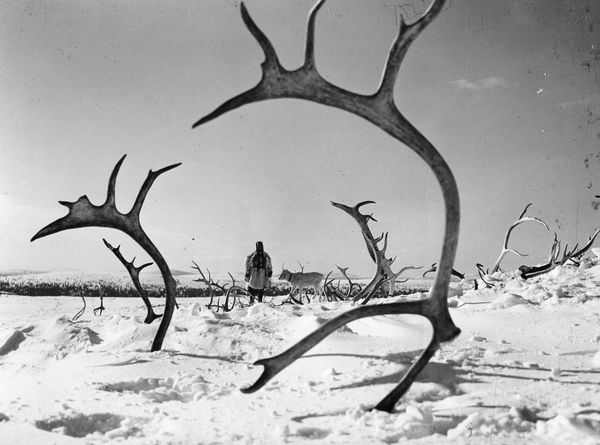Eye For Film >> Movies >> The White Reindeer (1952) Film Review
The White Reindeer
Reviewed by: Jennie Kermode

In the far Arctic lands, you need to be tough to survive. In some cultures women hunt alongside men, and none treats female muscularity as an unattractive trait, yet the need to preserve settlements and raise children means that there has long been a tendency for women of childbearing age to be left at home whilst the men travel. Reindeer hunters, following the herds, can be away for weeks or months at a time. It's the kind of separation that each generation of starry-eyed young lovers believes it can overcome, but the truth is that loneliness - especially for those left behind - can sometimes become too much to bear.
Pirita (played by Mirjami Kuosmanen, wife of director Erik Blomberg) is a young Lapp woman determined to take fate into her own hands. Her parents were happy that her husband could provide for her but she would rather he stayed at home more, rather than giving her a young white reindeer for her only company and disappearing into the snowy waste. She seeks help from a local shaman, asking him to make her so alluring that he'll never want to leave her. But when she touches his divining drum the shaman recoils in fear, realising something she never knew about herself - that she was born to be a witch.

There's an ancient enmity between Lapp witches and shamans, with their origins in Finnish culture, going back, it's said, to the creation of the world, when a Lapp witch shot the great shaman Väinämöinen with an arrow. Here, the tension between male and female magic and desire is enhanced by the cultural dynamic, Finns long having perceived their northern neighbours as wild and dangerous. Although the story that unfolds here, encapsulated at the start in song, is presented as folklore, 1952 was a time when some older Kuola Saami people still took seriously the ancient story that there was reindeer blood in their lineage. The shaman may himself by using Pagan magic, but here he is a figure of foreign, civilising influence or - depending on one's perspective - of colonial power. Although Pirita takes his advice to make a sacrifice at the Seita (the grove sacred to the Great Reindeer Spirit), what comes of it seems to owe more to his nature than to hers.
The white reindeer was a magical creature for the Lapps. To catch it was to secure good fortune, wealth and eternal happiness. Pirita's sacrifice of her much-loved pet in pursuit of her own ends is a dangerous act. It results in her becoming like the Kuomi Sami's famous ancestor, able to shift between human and reindeer form at will, and so fulfils he original desire, but what could be more alluring to a hunter than the sight of his quarry? Yet, as in all such stories, there is a terrible price to pay. To possess such allure is dangerous, as is Pirita's strange new appetite. Now men also fear her and seek her destruction.
Often described as one of Finland's earliest horror films, The White Reindeer isn't really scary but it is haunting. The lonely landscape, wrapped in snow, really makes its presence felt. To be an outcast in this place, afraid to approach the fire where men gather, is to risk death even if they play no direct part in it. The melancholy score, drawing on old folk melodies, seems to promise nothing but misfortune. Kuosmanen's performance is full of a sense of repressed power. In night-time scenes all the empty space seems to press in around flickering sources of light. The effect of it is not freeing but bizarrely claustrophobic.
With Kuosmanen featuring in nearly every scene, this is a film worth citing when people suggest that powerful, complicated female leads in horror films are a new thing. Though she is portrayed as villainous - and also tragic - the viewer is very much placed on her side and the film wrestles with issues around the policing of female sexuality and frustration of women's ambitions. The phallic imagery in some scenes - especially at the end and in the pivotal moment of the sacrifice - is somewhat over the top, but there are important ideas here nonetheless in a drama played out on the margins of the world where warmth is hard to find.
Reviewed on: 05 Apr 2019















